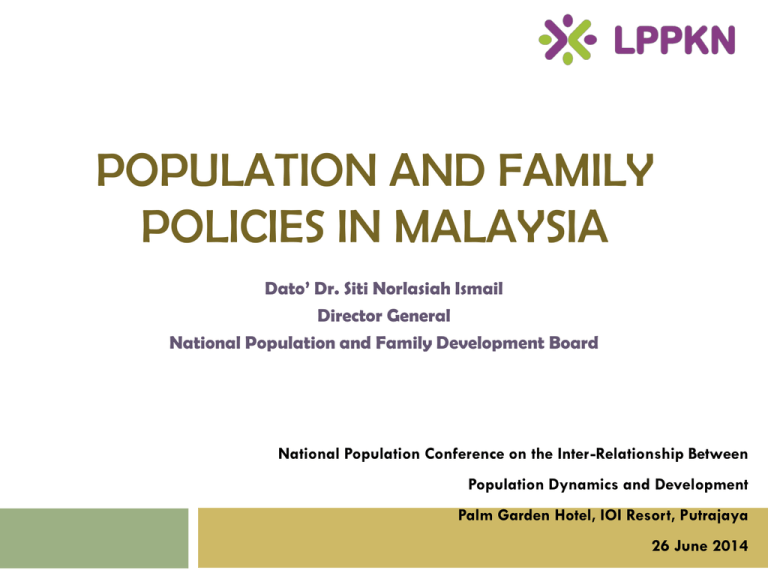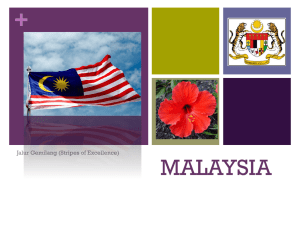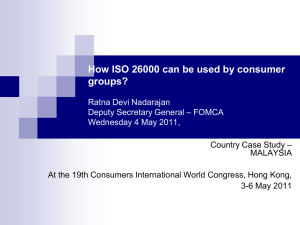Population and Family Policies in Malaysia
advertisement

POPULATION AND FAMILY POLICIES IN MALAYSIA Dato’ Dr. Siti Norlasiah Ismail Director General National Population and Family Development Board National Population Conference on the Inter-Relationship Between Population Dynamics and Development Palm Garden Hotel, IOI Resort, Putrajaya 26 June 2014 Malaysia Demographic Trends Evolution of Population Policy in Malaysia Other Population-related Policies Family in Malaysia Family Policy in Malaysia The National Family Policy Moving Ahead: Some Recommendations for Family Policy Can We Achieve 70 Million? 1970: 10.4 million 1957: 6.3 million 1991: 18.4 million 2000: 23.3 million 2010: 28.3 million Source: Department of Statistics Malaysia The Share of Working-Age Population has Soared from 50% in 1970 to 65% in 2010. But Young People is Declining Percent Distribution of Population and Dependency Ratio Age Group 1957 1970 1980 1991 2000 2010 0 - 14 43.8 44.9 39.9 36.5 33.3 27.4 15 - 59 51.6 49.9 54.6 57.7 60.5 64.8 60 and above 4.6 5.2 5.5 5.8 6.2 7.9 Source: Department of Statistics Malaysia We are at the “Replacement Fertility Level” ! 7.0 Total Fertility Rate 6.0 5.0 4.0 Total fertility rate, Malaysia, 1963 – 2012 6.0 4.9 3.9 3.4 3.0 2.1 3.0 2.0 1.0 1963 1965 1967 1969 1971 1973 1975 1977 1979 1981 1983 1985 1987 1989 1991 1993 1995 1997 1999 2001 2003 2005 2007 2009 2011 0.0 Source: Department of Statistics Malaysia, Various Vital Statistics, 1963-2010. People Now Marry Later Singulate mean age at first marriage (SMAM), Malaysia, 1970 to 2010 Year SMAM (years) Men Women 1970 25.6 22.1 1980 26.6 23.5 1991 27.9 24.6 2000 28.6 25.1 2010 28.0 25.7 Source: World Marriage Data 2012, United Nations Malaysia Will Becoming An Ageing Nation in 2035 Percentage of population aged 60 years or older, Malaysia, 1990 to 2040 16.3 14.9 13.6 12.2 10.6 9.1 7.6 5.8 5.7 1991 1995 6.2 6.6 2000 2005 2010 2015 2020 2025 2030 2035 2040 Source: Department of Statistics Malaysia (1995), Population and Housing Census of Malaysia, 1991. Department of Statistics Malaysia (2001), Population and Housing Census of Malaysia, 2000. Department of Statistics Malaysia (2012), Population Projections, Malaysia, 2010-2040 Evolution of Population Policy in Malaysia Began from the period of the 1st Malaysian Plan (19661970) Led to the passage of the National Family Planning Act No. 42, 1966 National Family Planning Programme launched Evolution of Population Policy in Malaysia •The Government recognised the inter-linkages between population and development processes •The Government recognised that continued population growth does not necessarily have a negative effect on development •A larger population, and the increased domestic market can be beneficial in achieving national development goals provided that the quality and productivity of the population are being constantly raised •A specific population size of 70 million was identified as an ideal target towards which Malaysia might aim at by 2100. Evolution of Population Policy in Malaysia Reassessment of the policy (Population Strategic Plan Study 1992) Sustain population growth that is in balance with resources and development Total fertility rate was dropping faster than expected The quantitative target of 70 million population by the year 2100 will, therefore, not be achieved Quality of the population is a more concern matter rather than quantity The main thrust of our future population programme is to sustain population growth that is in balance with resources and development The Vision 2020 Policy stresses human resource development as well as the need for the creation of an economically resilient and fully competitive community Evolution of Population Policy in Malaysia Second Population Strategic Plan Study, 2009 shows that Malaysian families are getting smaller and the total fertility rate is dropping much faster. Some recommendations: 1 • A period of paid paternity leave 2 • Paid compassionate leave in cases of children's sickness 3 • More flexible working hours 4 • Child-minding facilities at the workplace 5 • Government subsidies for childcare costs incurred by working mothers 6 • Increasing tax concession for dependent children 7 • Programmes to encourage husbands to be more fully involved in childrearing and household activities 8 • Unmet needs for contraception need to be fully met National Social Policy Other Populationrelated Policies National Policy on Women and Plan of Action National Policy for Older Persons and Plan of Action National Policy on Reproductive Health and Social Education National Social Policy (2003) NSP provides the framework for the planning and implementation of social development programmes, to create a progressive and established Malaysian society with every member having the opportunity to develop his/her potential. Specifically, the NSP seeks to: i. To ensure that the basic necessities of the individual, family and community are provided for; ii. To develop and empower humans for life; iii. To consolidate and develop the social support system and services; and iv. To generate multi-sector synergy. NSP being reviewed, to be replaced with a New Social Model. National Women Policy The setting/issues • • Women have made great stride in education, but still lagging in employment and decision-making. Increased recognition of women’s role. Policy response • The 1989 National Policy on Women was revised in 2009, to ensure an equitable sharing of resources and benefits of development for men and women. Impact • • • Increased female labor force participation, especially among the higher educated. More and more women are holding key positions in government and private sector. Contributing to family wellbeing and national development. National Policy for Older Persons and Plan of Action (2011) The setting/issues • • • • • • Increasing life expectancy Older people will make up 15% of pop by 2030 from 8% now Under-utilization of human resources Care and support dwindling extended family Inadequate social protection High cost of long term care Policy response • • • • New policy based on a review of the 1995 National Policy for the Elderly and the principles of the MIPAA, to ensure an enabling and supportive environment for the well-being of older people, and to promote healthy, active and productive ageing. Raise retirement age to 60. 100% tax rebate on cost to retrain older persons. Tax rebate of up to RM5,000 to encourage family care. Impact • • The effectiveness of the various programs has not been evaluated. More older people are expected to continue working following the extension of retirement age. National Policy on Reproductive Health and Social Education (PEKERTI) The setting/issues Policy response Impact • Problems of youth • National Reproductive • 2011- Implement of sexuality and RH Health and Social Reproductive Health and Education Policy in Social Education (RHSE) • Drug addiction 2009, aims to empower in the National Service • HIV/AIDS adolescents with Training Curriculum • Erosion of knowledge and positive (PLKN) PEKERTI@PLKN parental guidance attitudes towards social • 2012- PEKERTI@SEKOLAH • Negative influence and reproductive • The Government of of social media health. Malaysia has established thirteen youth-friendly adolescent centres known as kafe@TEEN Family in Malaysia: Socio-demographic context Number of Households, Family Size, Family Structure, 1980, 1991, 2000, 2010 1980 1991 2000 2010 Number of Households (million) 2.5 3.5 4.8 6.4 Average Family Size (persons) 5.22 4.92 4.62 4.31 Nuclear 55 60 65 70 Extended 28 26 20 18 Single 9 8 7 8 Family Structure (%) Source: Malaysian Census, 1980, 1991, 2000, 2010 Parental Leave Family policy in Malaysia Cash Allowances Flexible Working Arrangements programme • Maternity leave • Paternity leave • Divided into meanstested and non-means tested under Child Act 2001 and Care Centre Act 1993 • A collaboration between MWFCD and TalentCorp National Family Policy (2010) • NFP adopted in 2010 to prioritise family perspective in all development efforts to ensure quality generations. It aims to develop prosperous, healthy and resilient families to ensure social stability. • 3 Strategic Thrusts: Commitment/ involvement of various stakeholders; Enforcement of laws and regulations; and Services and family-friendly facilities are accessible. National Family Policy (2010): Strategies 1. Research and development on family wellbeing 2. Advocacy to prioritise family wellbeing 7. Monitoring and evaluation 6. Conducive environment for family empowerment 3. Training and lifelong education for human capital development and family wellbeing STRATEGIES 5. Consultation and strategic partnerships with various Governments agencies, private sector, NGOs, institutions of higher learning and the community 4. Provision of resources Current Programme for Family NFP 1Malaysia Family First Movement Family perspective commitment Review policies and laws to be more family friendly Accessibility to family friendly services Family Wellbeing Index 2011 Family relations 23 100.0 80.0 Housing & environment Family economy 60.0 40.0 20.0 0.0 Family health Family & religion Family & community Family Wellbeing Index Domain score Family & safety Moving Ahead: Recommendations for Family Policy Work-life balance deserves more attention Gender-neutral policy: More men should involve in child-rearing & household responsibilities On-site public-private partnership child care centre Preparation to an ageing nation: Harnessing the second demographic dividend & Inter-generational Transfer Need more resource for family policy 25








